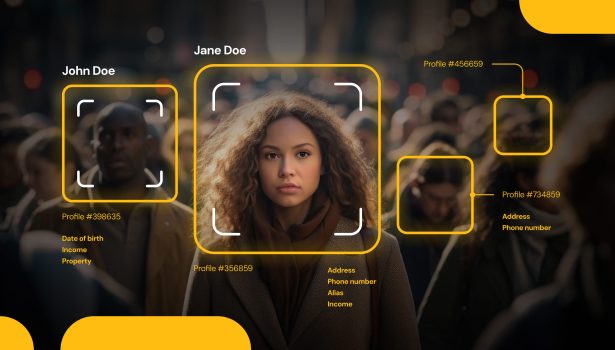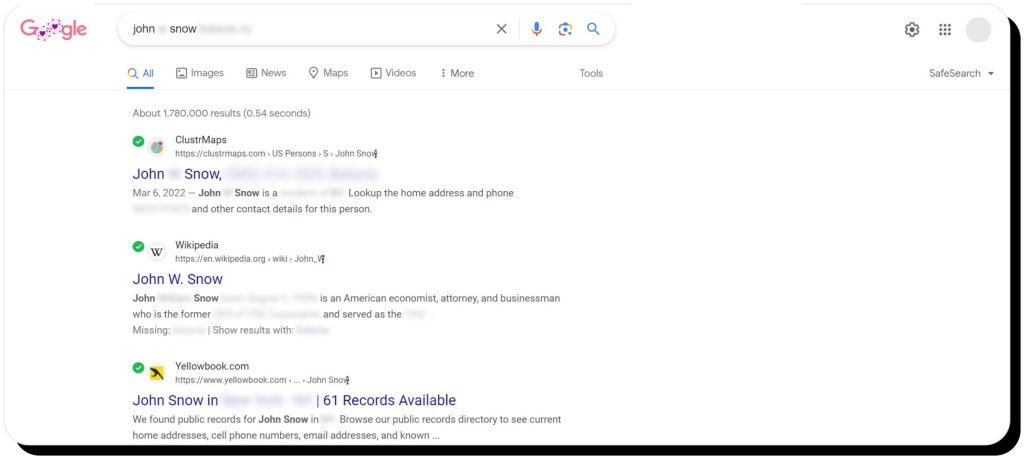6 easy ways to check your digital footprint

A digital footprint is the trail of your online activities that encompasses the bits you leave behind through intentional actions like posting on social media as well as data about you accumulated without your explicit consent and published by third parties. The latter include data brokers that collect your personal information from various sources and share it online, cookies that track your browsing history, and apps that track your location data.
While you can easily find some parts of your online footprint, you can’t access the whole trail you’ve left behind. That’s because numerous bits of this trail will always be stored by third-party services that you have no access to, e.g. Internet providers, website cookies, and various apps.
However, it’s crucial to monitor your online footprint and find every bit of it you can reach. Doing so will let you understand how much of your identity is exposed to the public Internet and take proactive measures to protect your privacy.
Here’s how to find your digital footprint.
Check your digital footprint on data broker sites
Data brokers contribute vastly to your digital footprint by aggregating all sorts of your personal information from numerous sources including public records, social media sites, marketing databases, retailers, and credit card companies. They then organize the collected data into personal background reports and publish them online. An average report reveals your home address, contact data, age, political and religious affiliations, hobbies and interests, family ties, credit score range, assets, net worth, and numerous other private details.
There are hundreds of data brokers out there and each can potentially publish your information. While you can find the biggest ones by Googling yourself, there is a plethora of smaller ones that don’t rank high in search engines but still expose your personal details.
Check your footprint on Google
Looking yourself up on Google is a great way to evaluate how the public Internet sees you online. To find as many results as possible, google different combinations of your name, aliases, addresses, and place of work. Start with your name + city + state. The majority of results will probably link to data brokers and social media platforms, but you may find various directories, blogs, forums, or news posts as well. Googling yourself is a great way to see both how much you’ve put out there yourself and what info has been generated by third parties.

Do a reverse image search
Another way to check your digital footprint on Google is to run a reverse image search for any of your photos. The results may pull up similar photos, information associated with your photo, and websites that publish the submitted photo. Another option is to run a similar search using services like TinEye instead of Google.
Check if your emails and passwords have been compromised
No company, however big or small, is immune to data breaches. This means that your emails, passwords, and other details may have been compromised through no fault of yours. Even though you can’t erase the information once it’s exposed, you can take proactive measures to protect the affected accounts.
Have I Been Pwned allows you to see whether your email address and passwords have been breached and set up notifications if a breach occurs in the future. If you have a Google account, you can use their password manager which will notify you of any vulnerabilities as well. Another option is to use services like Bitdefender Digital Identity Protection which scan the web for leaks of your personal data.
Request data collected by social media
Social media sites store massive amounts of data on their users that go beyond the photos posted and likes left. The personal information you input when signing up, the location you browse from, the topics you tend to react to more, the ads you click, the people you interact with, your device information – everything is tracked and stored.
Most social media sites allow you to request the data they have accumulated on you. Though the process varies, it’s usually done via the Settings & Privacy pages.
Request data from other platforms and services you use
In addition to social media, you probably have accounts on shopping sites, banking and credit platforms, streaming platforms, and various apps ranging from health trackers to smart home devices. Every service you use collects and stores your data, contributing to your digital footprint.
Most platforms will let you request the data they’ve gathered. In case a service doesn’t have clear data request policies, contact support and ask them what options you have.
How to remove your digital footprint
It should be noted that there’s no way to completely delete your digital footprint. Unless you stop using the Internet, you will always leave a trail behind. However, you can control what part of your footprint is publicly accessible and minimize the exposure of your personal information online.
It’s important to understand that deleting your digital footprint is a never-ending process that should be dealt with systematically. Here’s what you can do:
- Opt out of data broker and people-search sites
- Delete any old and unused online accounts
- Request third-party sites to remove your information. These include job boards, marketing databases, news platforms, other people’s blogs, company websites, etc.
- Delete old links from internet archives like Archive.org
- Erase browsing history and website cookies. Opt for browsing the internet in incognito mode, use a VPN and install ad blockers
- Remove the links with your personal information from Google
How Onerep protects your digital footprint
Onerep manages the digital footprint you have no control over. We remove your personal information from 230 data broker and people-search sites and, as a result, from Google. We use cutting-edge, fully automated processes and technologies with a proven record of successful removal of more than 14,000,000 unauthorized user profiles across hundreds of data broker sites.
Our process can be broken down into 4 steps:
Step 1. We scan data brokers via Onerep proprietary True Scan™ technology: While other services try to “guess” links to your profiles based on a link generation pattern, Onerep actually scans 230 data broker websites, identifying exact pages where your personal data is exposed.
Step 2. We send opt-out requests for every profile we have found: If a website shares more than one listing with your personal information, we remove all of them.
Step 3. We systematically check back to confirm your profile has been removed using our own Verified Removal™ process. Onerep follows up on deletion requests until we verify the opt-out.
Step 4. We continually monitor the web to make sure your private info stays off the Internet. Our proprietary technology performs monthly scans, checking for new or reappeared profiles on people-search websites. If any are found, we immediately start the removal.
With a 9-year track record and over 450,000 satisfied users, Onerep is here to help you stay informed about your information exposure and protected from multiple online threats by removing your private data from the web. Sign up today and regain control over your digital footprint.





Dimitri is a tech entrepreneur and founder of Onerep, the first fully automated data removal service. Top cybersecurity CEO of 2021 by The Software Report.